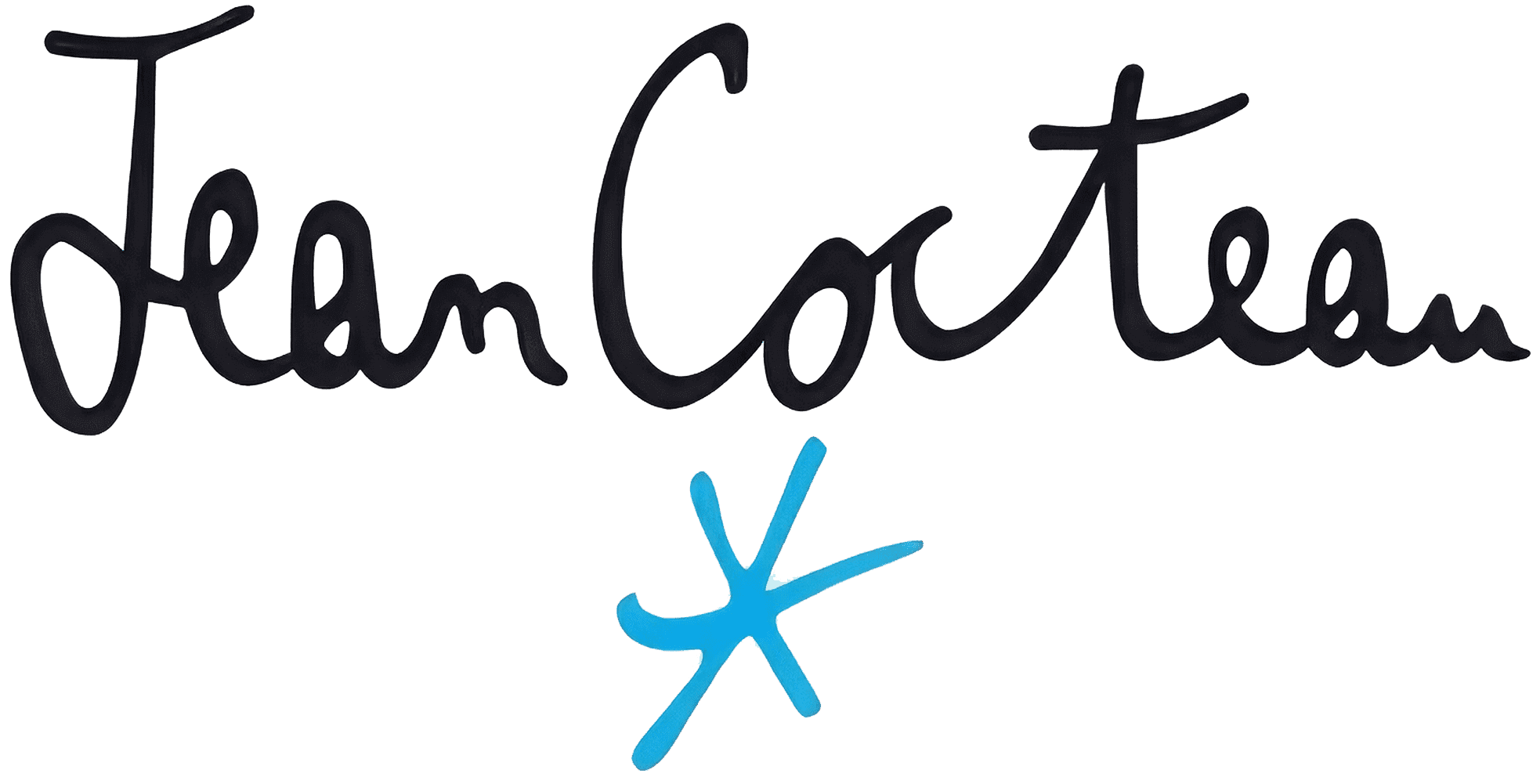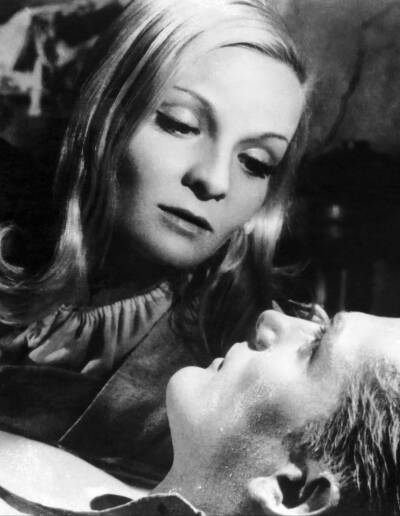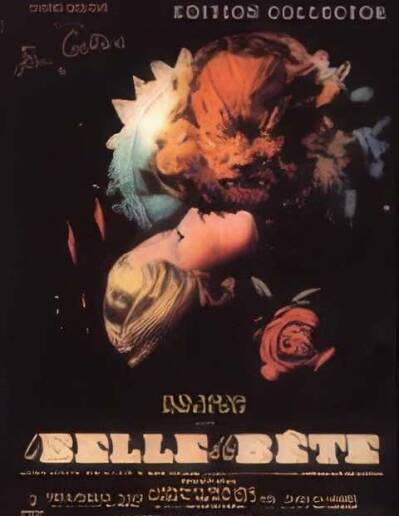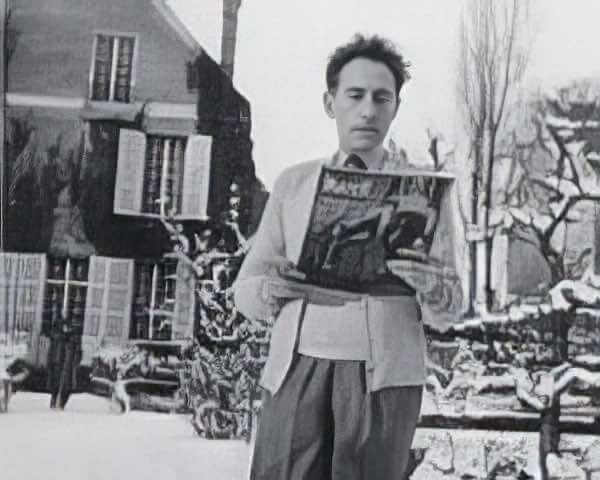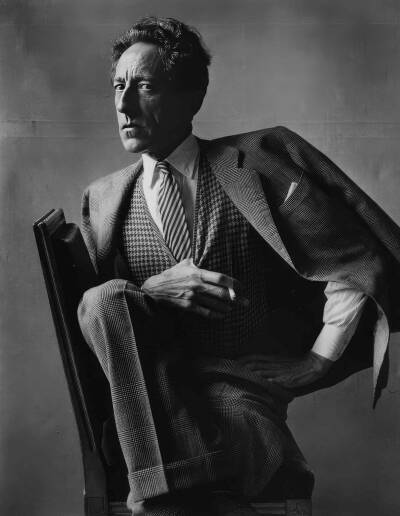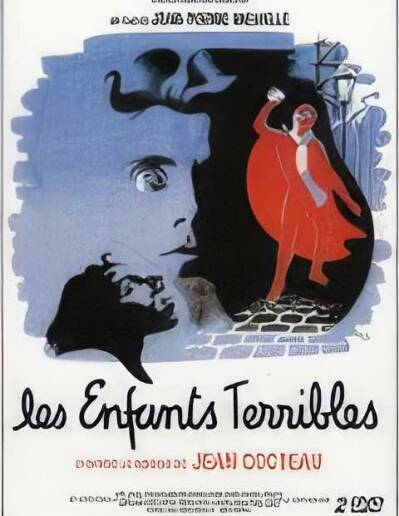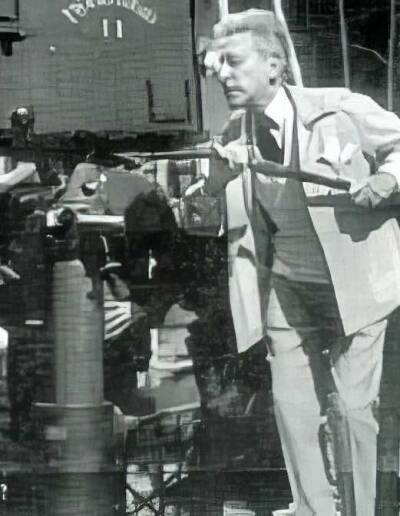Despite publishing Allégories, an anthology of poems in June, Cocteau primarily focuses his attentions on the theatre. In February, he designs the sets and costumes for Feydeau’s La main passe. On April 29th, the premiere of La Machine à écrire (The Typewriter) at the Théâtre Hébertot spurs virulent attacks from the collaborationist press: Rebatet and Laubreaux rage in the fascist-leaning Je suis partout. One evening in June, Jean Marais gives Laubreaux a good hiding. The play is banned. In July, an album of drawings linked to the Chevaliers de la Table ronde (Knights of the Round Table) is published. In August, it takes Cocteau just 18 days to write Renaud & Armide. In October, a revival of Les parents terribles (The Storm Within) at the Théâtre du Gymnase results in the play being banned. On December 7th, the ban is lifted and the play is received with loud applause. At the end of the year, Cocteau hires Paul Morihien as his secretary.
On January 19th, the play Renaud & Armide is accepted by the Comédie-Française, but rejected by Jérôme Carcopino, the Vichy government’s supervising Minister. Throughout the year, Cocteau meets frequently with Picasso, Eluard and Lise Deharme. He sees Ernst Jünger who is posted in Paris. Cocteau enters a period of intense cinematic activity: adaptation and dialogues for Marcel Lherbier’s La Comédie du bonheur and dialogues for Roland Tual unhappy with Charles Spaak’s screenplays for Lit à Colonnes. In early March, Cocteau begins writing a Journal. On May 15th, he attends the inauguration of an exhibition of his long-time friend, the German sculptor Arno Breker, at the Orangerie. On May 23rd, he publishes a "salute to Breker" in Comoedia and sparks intense criticism for doing so. He completes his screenplay for L’Eternel retour (The Eternal Return) and re-writes the Baron fantôme for Serge de Poligny.
Mme. Cocteau dies on January 20th. On January 27th, Antigone triumphs at the Opera. Two days later, Cocteau holds a poetry recital with Serge Lifar at the Théâtre Edouard VII. On February 6th, Cocteau is filled with enthusiasm at a reading of Genet’s Condamné à mort. On February 15th, he meets Genet. On April 14th, Renaud & Armide has its premiere at the Comédie-Française with Marie Bell, Mary Marquet, Maurice Escande and Jacques Dacquemine. The play is a huge success; however the collaborationist press continues to hound the author. On April 20th, Cocteau leaves for Nice for the filming of L’Eternel retour (The Eternal Return). Soon after his arrival, he develops a mild and easily-treated case of pneumonia. In August, he plays Musset in Sacha Guitry’s film La Malibran. He works on a study on El Greco to be published at the end of the year as well as on a play that will become L’Aigle à deux têtes (The Eagle Has Two Heads). On August 27th, Cocteau is attacked on the Champs-Elysées by members of a security force supervising a parade of French Volunteers who have enlisted to go to the Russian Front at the side of the Nazis. In October, L’Eternel retour (The Eternal Return) is screened in three cinemas. Jean Marais is a resounding success. Cocteau leaves with Marais and Paul Morihien for Tal Moor near Pont-Aven where they are guests of the Masson-Détourbets. Whilst there, Cocteau completes L’Aigle à deux têtes (The Eagle Has Two Heads).
He finishes Léone, a poem he has been working on since 1941. His project for La Belle et la Bête (Beauty and the Beast) takes form. The death of Giraudoux on January 31st, and more particularly that of Max Jacob at the holding camp in Drancy on March 5th, deeply affects Cocteau who had made every effort to obtain the release of his friend. On April 12th, he turns down an offer to succeed Vaudoyer as director of the Comédie-Française. On June 10th, four days after the Allied landings in Normandy, he attends a lecture given by Sartre at la Loggia on the Quai Voltaire. The lecture is followed by a debate on Dramatic Style. In early July, Jean Desbordes’ sister asks Cocteau to intervene to save her brother imprisoned for his activities in the Resistance. Cocteau tries but in vain: Jean Desbordes is executed on July 5th. After the liberation of Paris on August 25th, Jean Marais joins Leclerc’s Free French division and on September 7th leaves for the front. From the end of August onwards, Cocteau’s demeanour during the Occupation raises criticism. On November 23rd, he is summoned to appear before the collaborationist-purging Comité d’épuration du cinema. He is acquitted in minutes. He will also be acquitted when he appears before the Committee of Writers.
January sees readings of Léone by Cocteau himself, of Plein-chant (Plainsong) by Maria Casarès, and L’Ange Heurtebise (The Angel Heurtebise) by Marcel Herrand. In April, the poet writes the last page of the Journal that he started in March 1942. He and Georges Hugnet start writing poems on the tablecloths of the restaurant Le Catalan. He writes the dialogue for Bresson’s Dames du bois de Boulogne (Ladies of the Bois de Boulogne). La Belle et la Bête (Beauty and the Beast) is filmed at Rochecorbon near Tours between August 26th and September 13th. The last reels are shot in the studio and at the Château de Raray near Senlis. Cocteau, who has suffered from hives and acute inflammation since early October is finally hospitalised at the Hôpital Pasteur. Whilst there, he writes La Crucifixion. He is released from the hospital on November 1st and starts filming again on November 6th. Though still afflicted with abscesses, he works until the end of the year. He keeps a journal of the filming, which will be published in January 1947 (La Belle et la Bête. Journal d’un film – Beauty and the Beast. Diary of a filming).
Filming ends on January 11th and Cocteau begins the task of editing. On February 8th, Les Parents terribles (The Storm Within) is revived at the Théâtre du Gymnase. In mid-February, concerned that Cocteau may be suffering from jaundice, Darbon takes the poet to Morzine. Whilst there, Cocteau starts work on La Difficulté d’être (The Difficulty of Being). On June 25th, his ballet Le Jeune Homme et la Mort (The Young Man and Death) premieres at the Théâtre des Champs Elysées with Jean Babilée in the lead role. From July 25th to August 24th, Cocteau rests at the spa in La Rocheposay, Poitou. Jean Marais and the Vilmorins visit him. Whilst there, the poet writes Un ami dort (A Friend Sleeps) and works on the screenplay for Ruy Blas. In October, La Cruxifixion is published and the Aigle à deux têtes (The Eagle has Two Heads) has its world premiere in Brussels. La Belle et la Bête (Beauty and the Beast) opens in Paris at the Colisée and Madeleine cinemas. The film, overlooked at the Cannes Festival in September, is awarded the Louis-Delluc Prize in December. That same month, the first volume of Cocteau’s complete works is published by éditions Marguerat; the eleventh and final volume will be released in March 1951. On December 22nd, L’Aigle à deux têtes (The Eagle has Two Heads) is performed at the Théâtre Hébertot with Edwige Feuillère and Jean Marais in the leading roles.
In January, Cocteau buys a house in Milly-la-Forêt with Jean Marais; they take up residence in November. Though he writes L’Impromptu du Palais-Royal in April and draws his series of Licornes (Unicorns) in July, the greater part of the poet’s output during 1947 is cinema-based: in the spring, he follows the filming of Rossellini’s adaptation of La Voix humaine (The Human Voice) starring Anna Magnani, then the filming of Ruy Blas and finally, in October, the filming of L’Aigle à deux têtes (The Eagle has Two Heads). At the end of the year, he writes the screenplay for Orphée (Orpheus) and publishes La Difficulté d’être (The Difficulty of Being). In July, publisher Paul Morihien introduces him to Edouard Dermit, a young painter from Lorraine. Cocteau hires him as an assistant gardener at Milly and quickly makes him his chauffeur.
Cinema remains Cocteau’s primary focus throughout the year. Ruy Blas is released in February and L’Aigle à deux têtes (The Eagle has Two Heads) in September. Les Parents terribles (The Storm Within) is shot during May and June and released in November. In September, he takes up tapestry and creates a cartoon of Judith & Holopherne. Poésie 1946-1947 is published, as well as a children’s story, Drôle de ménage (Strange Household). At the end of December, Cocteau goes to New York to present L’Aigle à deux têtes (The Eagle has Two Heads), just as he had done in London in June.
Cocteau begins Lettre aux Américains (A Letter to the Americans) which will be published later that same year. From March 6th to May 24th, the stage productions of Les Parents terribles (The Storm Within), La Machine infernale (The Infernal Machine) and Les Monstres sacrés (Holy Monsters) go on tour to Egypt, Lebanon and Turkey. Jean Marais, Edouard Dermit, Yvonne de Bray and Gabrielle Dorziat are part of the troupe. A diary of the tour entitled Maalesh will be published in December. In May, the paperback compendium of his plays, Théâtre de poche, arrives in bookstores. During the summer, Cocteau adapts the Tennessee Williams play A Streetcar Named Desire and he organises the Festival du Film Maudit in Biarritz. The filming of Orphée (Orpheus) gets underway in August and continues into November. By the time filming is complete Cocteau is left with a bad case of sciatica. In December, shooting begins on Melville’s adaptation of Les Enfants terribles (Children of the Game). The poet meets 30-year-old Francine Weisweiller through Nicole Stéphane. An immediate and durable friendship begins. The year is also marked by the first official recognition of Cocteau and his works: on September 3rd, he is made a chevalier of the Légion d’honneur.
On March 1st, Orphée (Orphée) is screened at the Cannes Film Festival prior to its release in Paris at the end of the same month. The film will go on to receive the International Critics’ Prize at the Venice Film Festival in September. In Germany, Cocteau’s presentation of the film is a huge success. In May, he makes his first visit to Santo Sospir, Francine Weisweiller’s villa in Saint-Jean-Cap-Ferrat. The villa will become a third home to him. Whilst there, he sets about decorating the walls. The ballet Phèdre (Phaedra) for which Cocteau wrote the libretto and designed the sets and costumes premieres at the Paris Opera on June 14th. The ballet is choreographed by Lifar with music by Auric. In July, Cocteau takes the first steps to adopt Edouard Dermit – a process that will remain incomplete at his death. During the summer, the poet travels to Italy with Francine Weisweiller and Edouard Dermit. They make a stop at the Venice Film Festival. At the end of the year, he starts painting with an easel. He becomes a true celebrity and henceforth until his death he will be asked to preside over events, to write prefaces, to illustrate programmes and to design posters…
Madeleine Sologne and Jean Marais in L’Eternel Retour by Jean Delannoy
Madeleine Sologne and Jean Marais in L’Eternel Retour by Jean Delannoy
Les Enfants Terribles (Jean-Pierre Melville) Melville-Productions
Les Enfants Terribles (Jean-Pierre Melville) Melville-Productions
